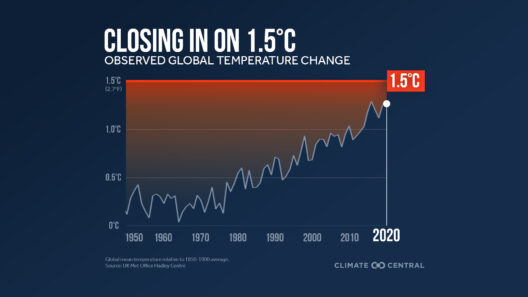In the grand tapestry of Earth’s history, countless threads weave together to form the intricate patterns of climate change. Among these threads, Milankovitch cycles stand as an enduring testament to the complex interplay between celestial mechanics and terrestrial phenomena. Named after the Serbian mathematician and astronomer Milutin Milanković, these cycles elucidate how variations in Earth’s orbit and axial tilt contribute to the rhythmic dance of glacial and interglacial periods.
The essence of Milankovitch cycles can be distilled into three primary components: eccentricity, axial tilt, and precession. Eccentricity refers to the shape of Earth’s orbit around the sun, which oscillates from nearly circular to more elliptical over a cycle of approximately 100,000 years. This orbital wobble modulates the distance between our planet and the sun, affecting the amount of solar radiation reaching Earth. As we ponder this cosmic ballet, one cannot help but marvel at the implications of such minute changes, akin to the gentle ripples that emanate from a pebble dropped in a serene pond.
Next, we encounter axial tilt, or obliquity, which represents the angle at which Earth’s axis leans in relation to its orbital plane. This tilt varies between roughly 22.1 and 24.5 degrees over a cycle of about 41,000 years. As Earth’s axis shifts, so too do the seasons—intensifying or moderating their severity. Picture a child swinging on a swing set; the higher the swing, the farther it travels from its starting point, producing a more exhilarating arc. Similarly, a greater axial tilt engenders stark seasonal contrasts, pushing regions toward extremes of heat and cold.
Lastly, we must consider precession, the slow wobble of Earth’s axis that results in a cyclical shift of the poles. This phenomenon unfolds on a grander scale over a period of about 26,000 years. As the axis wobbles, the orientation of Earth in its orbit alters, influencing the timing of the seasons. This reconfiguration is comparable to a musical conductor subtly adjusting the tempo of an orchestra, bringing forth rich variations in the climate symphony that echoes through the ages.
Together, these cycles intricately orchestrate Earth’s climatic variations, pushing and pulling in an elegant rhythm that resonates through millennia. Each cycle influences the onset and cessation of glacial periods, establishing a cadence between cold epochs and warmer interglacials. This dance has been documented and corroborated through various paleoclimate records, including ice cores, sediment deposits, and oceanic patterns. Through these records, scientists have charted the rise and fall of ice sheets, tracing the ebb and flow of temperature with meticulous precision.
The grandeur of Milankovitch cycles extends beyond mere numbers and graphs; it speaks to the very character of Earth’s climate. These cycles remind us that climate change is inherently linked to natural processes that have shaped our planet long before industrialization stamped its mark. Nevertheless, while Earth’s climate undergoes these astronomical influences, the current trajectory characterized by anthropogenic activities must not be ignored. Human-induced climate change, driven primarily by greenhouse gas emissions, has emerged as a formidable adversary to the Earth’s delicate equilibrium.
In examining the juxtaposition of natural cycles and human impact, we encounter pressing questions. What happens when the intricate dance of Milankovitch cycles is augmented by the frenetic tempo of human activity? As we pile emissions into the atmosphere like debris amid an elaborate performance, are we unwittingly crafting a cacophony that disrupts a centuries-old harmony? The implications are profound, suggesting that while natural cycles predetermine climatic rhythms, our actions may very well render these cycles irrelevant, thrusting us into a new epoch marked by unprecedented rates of change.
This realization underscores the importance of approaching climate advocacy with a holistic understanding of history. Milankovitch cycles teach us that Earth’s climate is a complex, interwoven system subject to both cosmic and terrestrial influences. By recognizing the ancient rhythms that have existed for eons, we can better comprehend how our current endeavors might resonate—or clash—with these pre-existing patterns.
Furthermore, the unique appeal of Milankovitch cycles beckons us to embrace a broader perspective. They are a poignant reminder of our interconnectedness with the universe. The dance of the Earth, the Sun, and the Moon orchestrates the very fabric of our existence; we are, quite literally, stellar citizens impacted by forces beyond our immediate comprehension. In our efforts to combat climate change, it becomes essential not only to advocate for stringent policies but also to foster a sense of awe for the very architecture of our climate system.
As we forge ahead in addressing the climate crisis, we must harness the insights gleaned from Milankovitch cycles while acknowledging the imperative of sustainability. By integrating knowledge of natural cycles into our efforts, we can cultivate strategies that align with the Earth’s rhythms rather than contradict them. This approach is not merely pragmatic; it represents a paradigm shift towards a more thoughtful and symbiotic relationship with our planet.
In conclusion, Milankovitch cycles serve as a powerful metaphor for the past, present, and future of climate dynamics. They compel us to reflect on the intrinsic connections that bind us to our planet and challenge us to tread lightly upon its surface. As we stand on the precipice of potential climate upheaval, it is incumbent upon each of us to engage with this knowledge, advocating for policies that resonate with the natural order and honor the delicate balance that sustains life on Earth.





